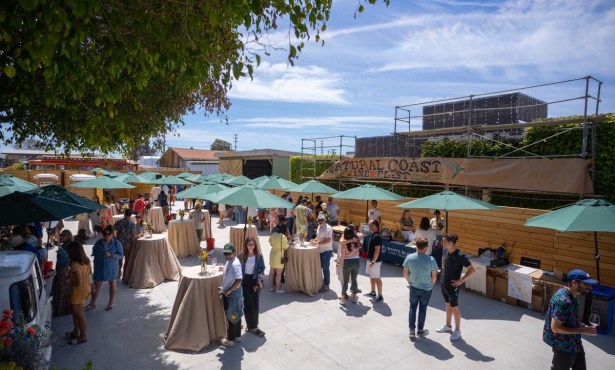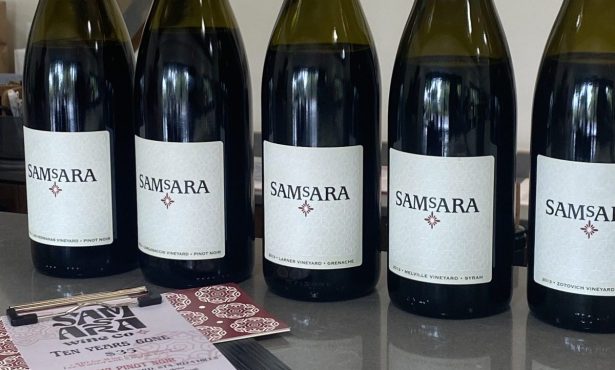Champagne on the Brain
Bounty of Bubbly Choices to Pop in the New Year; Plus, Which Cheese Will Please?
Every year ’bout this time, celebratory thoughts turn to the magical bubbling juice known as champagne. Thanks to its excitingly explosive nature, the drink has become the traditional go-to for optimistic parties such as weddings and New Year’s Eve. But in this age of adventurous wine-making and exploratory wine-drinking, that’s the only simple thing about champagne.

By now, even most casual wine fans these days know that “true” champagne only comes from the Champagne region of France, and that other bubblies boast names related to their place of origin. There’s cava from Spain; sparkling wine from America; sekt from Germany; cremant from other parts of France; and spumante in Italy (where things get more confusing thanks to such specific sparklers as prosecco, asti, and the half-bubbled frizzante). I’m not sure what they call them, but Hungary and South Africa are making quaffable bubblies these days, too. Then there’s the plentitudes of pink roses from all over and the strange sparkling red wines being made in Australia, Moldova, and beyond. Since champagne refers to the method, not the grape, the flavors you encounter could range from dry pinot noirs and crisp chardonnays to sweet muscats and zesty chenin blancs-or, better yet, a blend of many different varietals. And because sparkling makers are most concerned about producing a consistent product each season, they’re also known to blend different harvest years, hence the designation “NV” for “non-vintage.”
But don’t fear the dizzying details, because it just means that there’s no longer just one right way to pop in the New Year. There are more choices than ever before for champagne sippers this holiday season, and plenty of price points available to both please your palate and protect your bank account. That was the loud and clear message I got from attending a recent Saturday afternoon champagne tasting at the Wine Cask (813 Anacapa St., 966-9463, winecask.com), where a couple dozen folks gathered to try 15 different sparklers, from $16 bottles of Marquis de la Tour from Languedoc, France, to the $215 NV Brut “Grande Cuvee” from Krug.
In charge of the “bargain” table was Tom Keim, the Wine Cask’s new sommelier who formerly owned a chain of Southern California wine stores. “We call him the professor,” a woman informed me, and Keim certainly knew his bubbly. Within minutes, I learned that “cremant” was a reference to “creamy,” as in less bubbly, which is what the French outside of Champagne first promised to make; in generations since that pledge, the cremants have become as bubbly as champagnes, probably making Dom Perignon-the monk who perfected the bubbles-roll over in his grave. Keim also explained that the Hungarians used to make wines for the Russian czars, including wines made only from “table juice,” or the highly sweet nectar that leaked out of recently harvested grapes that hadn’t been crushed.
Hungary, in fact, was one of the unexpected stars of Keim’s table, namely the Torley NV Brut “Grande Cuvee” ($20), which was a pleasant diversion from the usual European and American fare. But that’s not to say that the Drusian Francesco NV Prosecco di Valdobbiadene ($20) from Italy wouldn’t be a fresh start to any meal, or that the subtle and smooth Segura Viudas NV Brut Cava “Aria” ($18)-a cuvee of macabeo, parellada, and xarel grapes from Northern Spain-wouldn’t be appreciated by even the snobbiest wino. The most requested Golden State refill was J Vineyards’ NV Brut “Cuvee 20” ($30), though there also were fans of Domaine Chandon’s Brut “Etoile” ($35) and Brut Rose “Pinot Noir Reserve” ($30). (I remain partial to anything put out by Laetitia Winery in Arroyo Grande, but only Northern California made an appearance.)
What about that $215 Krug? That was being poured at the true champagne table sponsored by distributor Mo»t & Hennessey, and it tasted mighty fine, as did Veuve Clicquot’s 1998 “Le Grande Dame” ($179). But the winner for me was the more “reasonably” priced Dom Ruinart’s NV Brut “Blanc de Blancs” ($96), whose silky bubbles threw off very tangible traces of cinnamon and vanilla, even after a whole slate of champagnes had slid across my tongue.
While the wisdom and pride that go into these more expensive bottles was immediately evident-I think anyone would agree they’d whip the cheaper ones in a blind taste test-dropping a considerable percentage of a paycheck on bubbly isn’t for everyone. But if the tasting revealed anything, it’s that we needn’t spend so much to party properly these days. Happy cork popping.
Pass The Cheese Please
Earlier this month, C’est Cheese (825 Santa Barbara St., 965-0318, cestcheese.com) hosted its third annual champagne and cheese tasting class, which always sells out fast, as do most of its monthly pairing sessions. Because of their unique textures and tastes, owner Kathryn Graham explained, “Sparkling wines are by far the easiest wines to pair with cheese.” With the help of a Baumard Cremant ($23) and a Villa Sandi Prosecco ($19), Graham taught us about the following cheeses, and why they go so well with champagne.
Nevat: This goat’s milk cheese made since 1992 by a farmer in Catalonia, Spain, is hardened in a bag and named after snow, a reference to its soft, fluffy texture.
Mt. Tam: The flagship cheese of the Cowgirl Creamery in Marin County, the cow’s milk for this double cream concoction-“anymore cream and it’s butter,” quipped Graham-comes from the organic Straus Family Creamery and is modeled on cheese from Champagne, France.
Ewephoria: This take on gouda, but using sheep’s milk, is one of the most popular sellers. Why? Because, said Graham, “It’s essentially like cheese candy.”
Vella Dry Jack: When Italian families in the Bay Area started aging David Jacks’s Monterey cheese generations ago as a replacement for their hard parmesans, they never knew they would make such a perfect pairing for tongue-tingling wine.
Saint Agur: Fluffy with a “butteriness that balances the saltiness,” Graham promised that this mild bleu cheese is even liked by those usually afraid of the moldy funk



